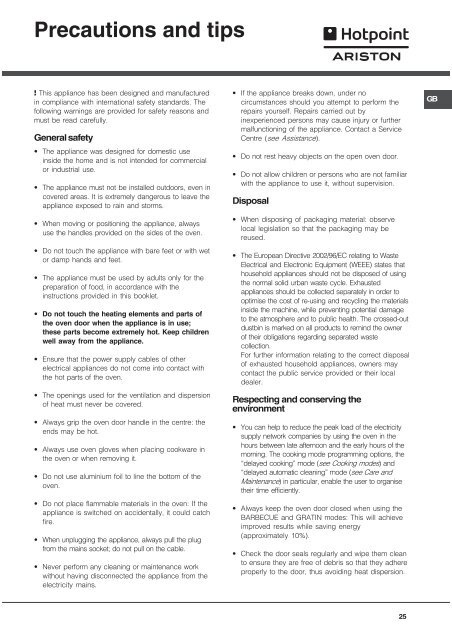KitchenAid F 1012.1 IX /HA - Oven - F 1012.1 IX /HA - Oven PT (F051609) Istruzioni per l'Uso
KitchenAid F 1012.1 IX /HA - Oven - F 1012.1 IX /HA - Oven PT (F051609) Istruzioni per l'Uso
KitchenAid F 1012.1 IX /HA - Oven - F 1012.1 IX /HA - Oven PT (F051609) Istruzioni per l'Uso
Create successful ePaper yourself
Turn your PDF publications into a flip-book with our unique Google optimized e-Paper software.
Precautions and tips<br />
! This appliance has been designed and manufactured<br />
in compliance with international safety standards. The<br />
following warnings are provided for safety reasons and<br />
must be read carefully.<br />
General safety<br />
• The appliance was designed for domestic use<br />
inside the home and is not intended for commercial<br />
or industrial use.<br />
• The appliance must not be installed outdoors, even in<br />
covered areas. It is extremely dangerous to leave the<br />
appliance exposed to rain and storms.<br />
• When moving or positioning the appliance, always<br />
use the handles provided on the sides of the oven.<br />
• Do not touch the appliance with bare feet or with wet<br />
or damp hands and feet.<br />
• The appliance must be used by adults only for the<br />
preparation of food, in accordance with the<br />
instructions provided in this booklet.<br />
• Do not touch the heating elements and parts of<br />
the oven door when the appliance is in use;<br />
these parts become extremely hot. Keep children<br />
well away from the appliance.<br />
• Ensure that the power supply cables of other<br />
electrical appliances do not come into contact with<br />
the hot parts of the oven.<br />
• The openings used for the ventilation and dis<strong>per</strong>sion<br />
of heat must never be covered.<br />
• Always grip the oven door handle in the centre: the<br />
ends may be hot.<br />
• Always use oven gloves when placing cookware in<br />
the oven or when removing it.<br />
• Do not use aluminium foil to line the bottom of the<br />
oven.<br />
• Do not place flammable materials in the oven: If the<br />
appliance is switched on accidentally, it could catch<br />
fire.<br />
• When unplugging the appliance, always pull the plug<br />
from the mains socket; do not pull on the cable.<br />
• Never <strong>per</strong>form any cleaning or maintenance work<br />
without having disconnected the appliance from the<br />
electricity mains.<br />
• If the appliance breaks down, under no<br />
circumstances should you attempt to <strong>per</strong>form the<br />
repairs yourself. Repairs carried out by<br />
inex<strong>per</strong>ienced <strong>per</strong>sons may cause injury or further<br />
malfunctioning of the appliance. Contact a Service<br />
Centre (see Assistance).<br />
• Do not rest heavy objects on the open oven door.<br />
• Do not allow children or <strong>per</strong>sons who are not familiar<br />
with the appliance to use it, without su<strong>per</strong>vision.<br />
Disposal<br />
• When disposing of packaging material: observe<br />
local legislation so that the packaging may be<br />
reused.<br />
• The European Directive 2002/96/EC relating to Waste<br />
Electrical and Electronic Equipment (WEEE) states that<br />
household appliances should not be disposed of using<br />
the normal solid urban waste cycle. Exhausted<br />
appliances should be collected separately in order to<br />
optimise the cost of re-using and recycling the materials<br />
inside the machine, while preventing potential damage<br />
to the atmosphere and to public health. The crossed-out<br />
dustbin is marked on all products to remind the owner<br />
of their obligations regarding separated waste<br />
collection.<br />
or further information relating to the correct disposal<br />
of exhausted household appliances, owners may<br />
contact the public service provided or their local<br />
dealer.<br />
Respecting and conserving the<br />
environment<br />
• You can help to reduce the peak load of the electricity<br />
supply network companies by using the oven in the<br />
hours between late afternoon and the early hours of the<br />
morning. The cooking mode programming options, the<br />
“delayed cooking” mode (see Cooking modes) and<br />
“delayed automatic cleaning” mode (see Care and<br />
Maintenance) in particular, enable the user to organise<br />
their time efficiently.<br />
• Always keep the oven door closed when using the<br />
BARBECUE and GRATIN modes: This will achieve<br />
improved results while saving energy<br />
(approximately 10%).<br />
• Check the door seals regularly and wipe them clean<br />
to ensure they are free of debris so that they adhere<br />
pro<strong>per</strong>ly to the door, thus avoiding heat dis<strong>per</strong>sion.<br />
GB<br />
25
















